
Jersey, officially known as the Bailiwick of Jersey, is an island country and self-governing British Crown Dependency near the coast of north-west France. It is the largest of the Channel Islands and is 14 miles (23 km) from the Cotentin Peninsula in Normandy. The Bailiwick consists of the main island of Jersey and some surrounding uninhabited islands and rocks including Les Dirouilles, Les Écréhous, Les Minquiers, and Les Pierres de Lecq.

Jersey – the largest of the Channel Islands – has been an island for around 6,000 years. Early inhabitation is evidenced by various neolithic monuments and hoards. In the 10th century, Jersey became part of Normandy. When the Normans conquered England in the 11th century, Jersey remained a part of the Duchy of Normandy, but when Normandy and England were finally split in the 13th century, the Channel Islands remained loyal to the English Crown, splitting Jersey politically from mainland Normandy.

Transport in Jersey is primarily through the motor vehicle. The island, which is the largest of the Channel Islands has 124,737 registered vehicles (2016). The island is committed to combatting climate change, having declared a climate emergency, and policy is focused on reducing dependence on the car. The island has a cycle network and bus service. The primary modes of transport for leaving the island are by air or sea.

St Helier is the capital of Jersey, the largest of the Channel Islands in the English Channel. St Helier has a population of 35,822 – over one-third of the total population of Jersey – and is one of the twelve parishes of Jersey. The town of St Helier is the largest settlement and only town of Jersey. The town consists of the built-up areas of St Helier, including First Tower, and parts of the parishes of St Saviour and St Clement, with further suburbs in surrounding parishes. The greater part of St Helier is rural.
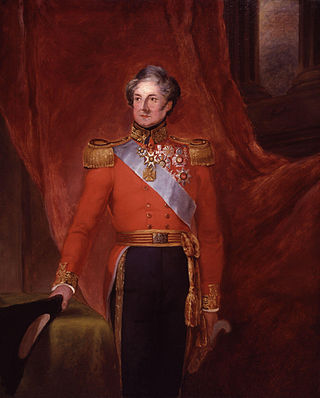
General Sir Colin Halkett was a British Army officer who became Lieutenant Governor of Jersey.

The culture of Jersey is the culture of the Bailiwick of Jersey. Jersey has a mixed Franco-British culture, however modern Jersey is culture is very dominated by British cultural influences and has also been influenced by immigrant communities such as the Bretons and the Portuguese.
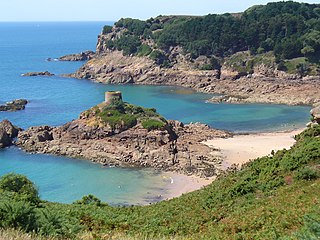
St Brelade is one of the twelve parishes of Jersey in the Channel Islands. It is around 7 kilometres (4.3 mi) west of St Helier. Its population was 11,012 as of 2021.

St Saviour is a parish of Jersey in the Channel Islands. It is located directly east of St Helier. It has a population of 13,580. It has a land surface area of 3.6 square miles and has a very small coastline at Le Dicq.

St Clement is one of the twelve parishes of Jersey in the Channel Islands. Its parish hall is around 3.6 kilometres (2.2 mi) south-east of St Helier. The parish has a population of 9,221 and is the second most densely populated.

St Martin is one of the twelve parishes of Jersey in the Channel Islands. It is 5.5 kilometres (3.4 mi) north-east of St Helier. It has a population of 3,948. The parish covers 10.3 km2 (4.0 sq mi).

Trinity is one of the twelve parishes of Jersey in the Channel Islands. It is 5.8 kilometres (3.6 mi) north of St Helier. It has a population of 3,156. The parish covers 6,975 vergées (12.3 km2 [4.7 sq mi]). Les Platons in the north of the parish is the highest point in Jersey. The parish borders St John, St Helier, St Saviour and St Martin.
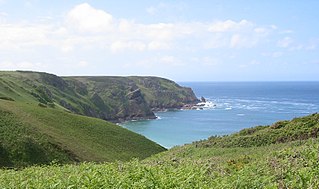
St Ouen is one of the twelve parishes of Jersey in the Channel Islands. It is around 8.8 kilometres (5.5 mi) north-west of St Helier. It has a population of 4,097. The parish is the largest parish by surface area, covering 8,525 vergées (15 km2), and is located in part on a peninsula.

St Lawrence is one of the twelve parishes of Jersey in the Channel Islands. It is located 8.0 kilometres (5.0 mi) west of St Helier. The parish covers 5,258 vergées (9.5 km2) and occupies the centre of the Island. St Lawrence Village is also the name of a village in the parish.

Gorey is a village in the parishes of St Martin and Grouville on the east coast of Jersey. The harbour is one of the three main harbours of the island, and is located in St Martin. The main centre of the village is located at Gorey Pier near Mont Orgeuil Castle, a 13th century fortification, in St Martin, while there is a small community with a few shops and restaurants. The church in the village is known as Gouray Church.

St. Aubin is a town and port in St. Brelade in Jersey, the largest of the Channel Islands. It is located on the western end of St. Aubin's Bay, on the south coast of the island, opening out into the Gulf of Saint-Malo.
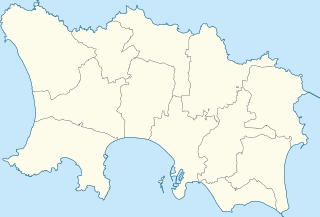
The parishes of Jersey are the civil and religious administrative districts of Jersey in the Channel Islands. All have access to the sea and share a name with their ancient parish churches. The parishes and roles within them are based on ancient Jersey law, drawing from the Norman customary law system. As such, many of the parish roles and structures have often been ill-defined.

Mont Orgueil is a castle in Jersey that overlooks the harbour of Gorey; a port on the east coast of the Island. It is known as Gorey Castle by English-speakers, and lé Vièr Châté by Jèrriais-speakers. The castle was first referred to as 'Mont Orgeuil' in an ordnance survey made in 1462, when the castle was under French occupation in the late Middle Ages. The castle was the seat of royal authority on Jersey throughout the medieval period and served as the main fortress on the Island until the construction of Elizabeth Castle in 1594. It is classified as a Grade I listed building.

Elizabeth Castle is a castle and tourist attraction, on a tidal island within the parish of Saint Helier, Jersey. Construction was started in the 16th century when the power of the cannon meant that the existing stronghold at Mont Orgueil was insufficient to defend the Island and the port of St Helier was vulnerable to attack by ships armed with cannons.
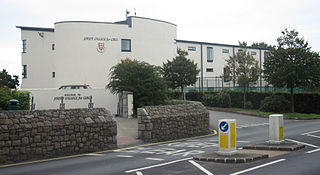
Jersey College for Girls is a government-run, fee-paying, academically selective secondary school for girls in Saint Saviour, Jersey. It was founded in 1880 in Saint Helier as Jersey Ladies' College. In 1887, the college moved to a purpose-built site on La Poquelaye and in 1999, it moved again to its present site, on Mont Millais, across from Victoria College, the government fee-paying school for boys.
The history of theatrical performances in Jersey can be traced back to the 18th century. The Opera House, opened by Lillie Langtry in 1900, and the Jersey Arts Centre are the main performance spaces, although performances also take place in parish halls and other venues.




















